I’m very proud to present the fine work of Stefano Crosio today. Many of you know him already from Clicks & Corks and Flora’s Table, if not, please give him a visit and say hello!
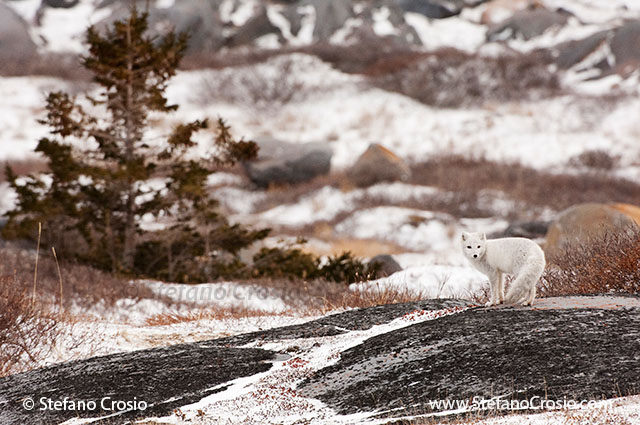
Nikon D2x 200 -400mm f/4.0 f/9 1/250 Iso 400 400mm
Canada, Hudson Bay: Arctic fox (Alopex lagopus) and tundra vegetation
This first awardwinning image is one of my favourites. Be aware of the expressions of the animals, have you seen anything like this? I have learned a lot from Stefano, let’s read what he writes himself about going to The Far North with a camera:
♦
The images on this post are a selection from three trips I made to the subarctic regions of Canada and Japan, namely Nunavut, the western shores of the Hudson Bay in the Canadian province of Manitoba, and eastern Hokkaido, Japan.
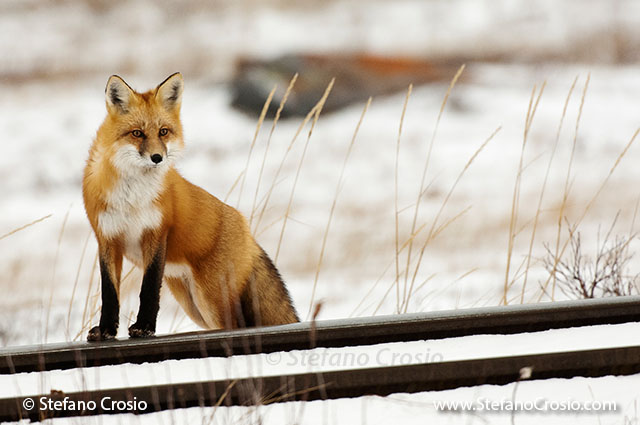
Nikon D2x 200 -400mm f/4.0 f/5.6 1/500 Iso 400 400mm
Canada, Hudson Bay: Red fox (Vulpes vulpes) near rail tracks
The base idea that my gracious host Dina (thank you very much again for having me here!) and I shared was to show, in a limited number of images, the richness in wildlife, vegetation and even human settlements that the subarctic regions of the North of the world offer to those who make the effort of traveling (quoting the popular HBO series Game of Thrones) “North of the Wall”.
Nikon D2x 200.-400mm f/4.0 f/7,1 1/3.200 Iso 500 400mm
Japan, Eastern Hokkaido: Steller’s sea eagle (Haliaeetus pelagicus) in flight
I hope that my images will mostly speak for themselves (and at any rate, I have provided caption information for each of them, just in case!), so I will only provide some basic information about the three regions that I mentioned above as well as a few essential tips in terms of how to prepare for a wildlife photography expedition up North, in case you decide to embark on such an adventure. Any other question, feel free to ask me through the comment section below and I will be glad to help as much as I can.
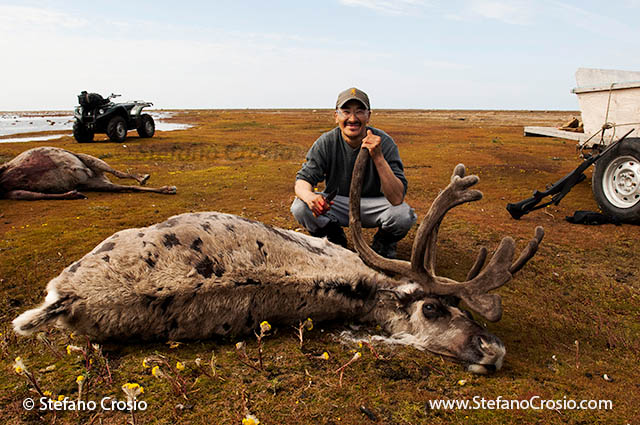
Nikon D2x 17 -35mm f/2.8 f/11 1/200 Iso 200 17mm
Canada, Nunavut: Inuit hunter with his caribou prey
Nunavut is the northernmost of the three regions where the images shown here were taken, and it is the largest and newest territory in Canada. It was created in 1999 by splitting the now adjacent Northwest Territories into two. Despite its huge size (over 2 million square kilometers/800,000 sqm), Nunavut has just above 31,000 residents (about 1.3 people every 100 square kilometers!), some 85% of whom are Inuit. Inuit are one of the three groups of Aboriginal people who live in the Canadian Arctic (the other two groups being First Nations and Métis): Inuit speak a language called Inuktitut (Nunavut and Inuit are two Inuktitut words respectively meaning “our land” and “the people“) and some of them also speak English. Just to give you an idea, the average temperature in Nunavut in January is -30 C/-22 F and in July 15 C/59 F.

Nikon D2x 200 -400mm f/4.0 f/5,6 1/250 Iso 640 380mm
Canada, Hudson Bay: Polar bear (Ursus maritimus) sow with cub hunting for seals
The western shores of the Hudson Bay in Manitoba (Canada) have become quite famous among arctic wildlife aficionados because in or around late October/early November large numbers of polar bears congregate there after hibernation waiting for the sea water to freeze so they can venture out on the ice to try and capture one of their favorite preys: seals.
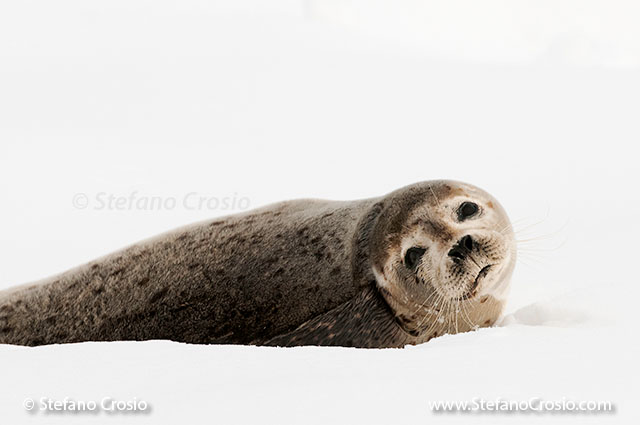
Nikon D300 200 -400mm f/4.0 f/7,1 1/2.500 Iso 500 400mm
Japan, Eastern Hokkaido: Spotted seal (Phoca largha)
Finally, Hokkaido is the northernmost among Japan’s largest islands, just south of Russia’s Kamchatka Peninsula. Interestingly enough, in between Hokkaido and Kamchatka lies an island chain known as the Kurils: these are the subject of a longstanding dispute between Japan and Russia as to which of the two countries the Kurils should belong to. Because of this dispute, Russia and Japan have not yet signed a peace treaty to end World War II! In the winter, large numbers of sea eagles and red-crowned cranes congregate on the eastern shores of Hokkaido to hunt for fish.
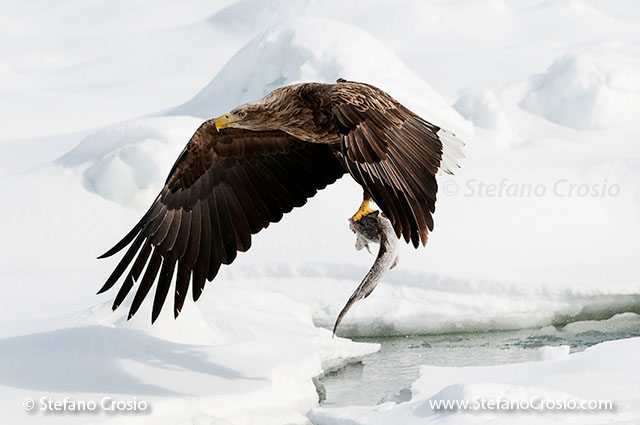
Nikon D300 200 -400mm f/4.0 f/7,1 1/3.200 Iso 400 400mm
Japan, Eastern Hokkaido: White-tailed sea eagle (Haliaeetus albicilla) with fish in flight
Let’s now move on to five basic tips that you may want to bear in mind if you decide to go on a photographic expedition to the Far North:
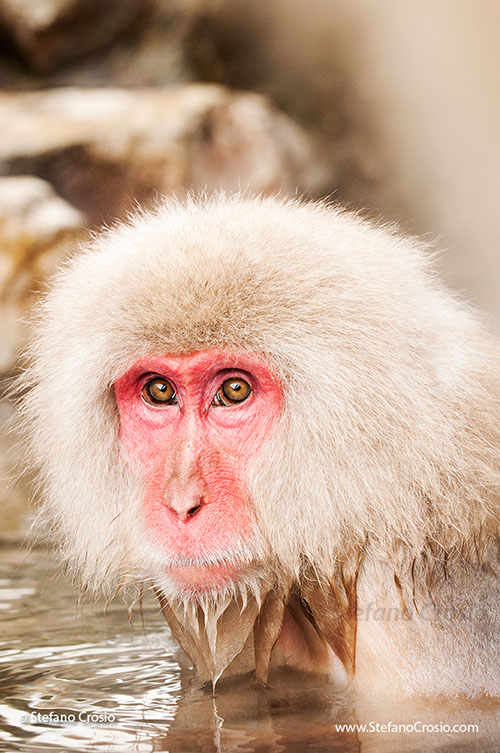 Nikon D300 70 -200mm f/2.8 f/7,1 1/200 Iso 640 95mm
Nikon D300 70 -200mm f/2.8 f/7,1 1/200 Iso 640 95mm
Japan, Nagano (Honshu): Snow monkey (Macaca fuscata)
1. If photography is the focus (pardon the pun!) of your expedition, make sure you have a capable system with you, which means one or more SLR cameras and a selection of lenses, including at least a wide angle, a short to medium tele (I find that a 70-200 zoom is often a great choice) and a long lens (something 300mm and above, ideally with a teleconverter) along with a sturdy tripod and head. If you are incurring the expense to go that far, you want to have the right equipment with you!
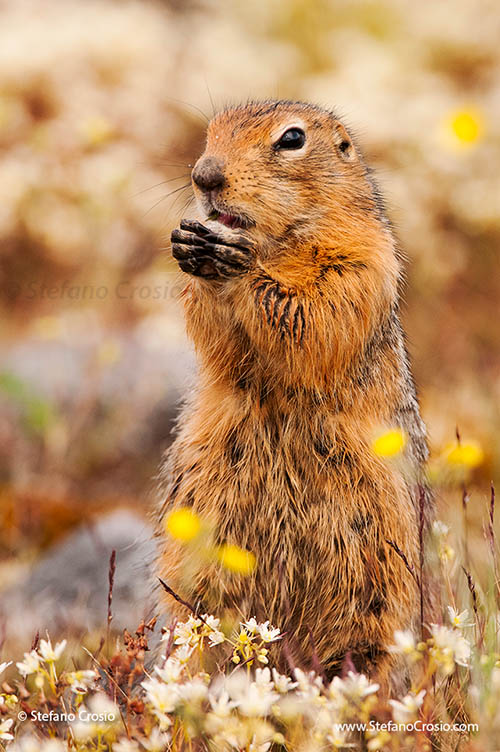 Nikon D300 200 -400mm f/4.0 f/7,1 1/500 Iso 500 330mm
Nikon D300 200 -400mm f/4.0 f/7,1 1/500 Iso 500 330mm
Canada, Nunavut: Arctic ground squirrel, or sik-sik (Spermophilus parryii)
2. Remember, depending on the time of the year you go, it will likely be seriously cold up there, so dress appropriately and work something out that will allow your hands and fingers to operate the camera without getting frostbite on your fingers (not fun). I often use thin windproof liners underneath insulated gloves, so when the time comes to photograph I take my right glove off and still have some protection of my right hand and fingers: at low temperatures, metal becomes icy cold and touching the metal parts of your camera with your bare skin is anything but a pleasant experience!

Nikon D2x 105.0 mm f/2.8 f/36 1/15 Iso 200 105mm
Canada, Nunavut: Tundra lichens
3. Bring one spare battery for your camera and keep it on yourself, next to your body when you are out photographing: cold reduces battery life and keeping the spare one warm will ensure that you keep going uninterruptedly in case the one in your camera is drained by the cold.
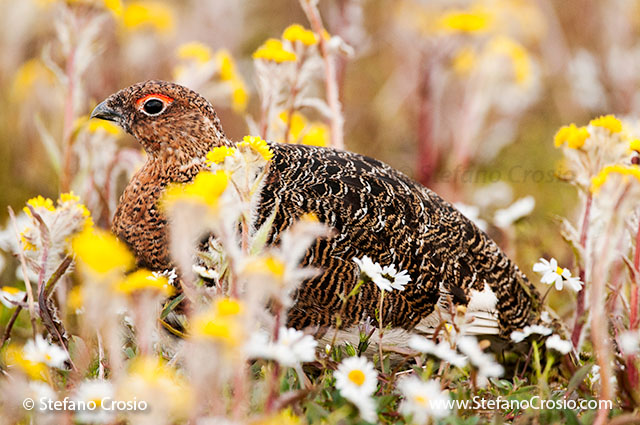
Nikon D300 200 -400mm f/4.0 f/5,6 1/125 Iso 400 400mm
Canada, Nunavut: Willow ptarmigan (Lagopus lagopus) in summer plumage
4. Bring plenty of large capacity, fast memory cards (assuming you shoot digital): you do not want to run out of space or fill the buffer when you are out there witnessing that once in a lifetime photo opportunity! Also, bring a fast card reader with you and at night be diligent and download all the images you shot during the day so you empty your cards for the next day. Depending on how paranoid you are about potential data loss, you may consider bringing a portable external hard drive to connect to your laptop and backup your images.
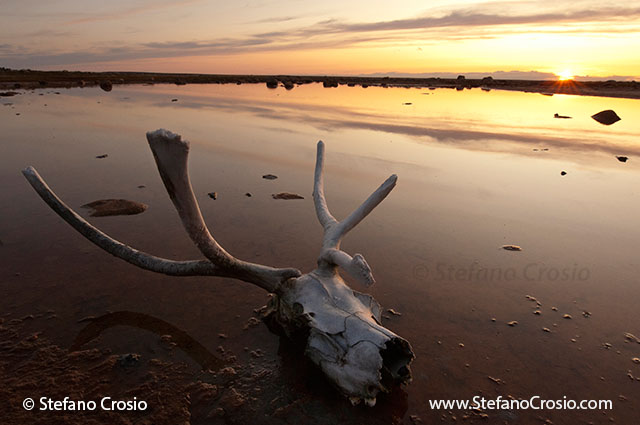
Nikon D2x 14-24mm f/2.8 f/16 1/20 Iso 200 14mm
Canada, Nunavut: Sunset over tundra pond with caribou (Rangifer tarandus) skull
5. Finally, know your camera settings and controls inside and out (when you are out there, it is not the time to fumble with a manual to remember how to activate auto-ISO or change the AF mode…). Also, do some research on the wildlife you will be likely to encounter during your trip so that you know what to expect and maybe you can anticipate some cool move of your subjects thanks to that knowledge. Thank you for reading and for looking at my images: I hope they inspired you to plan a visit to the Far North!
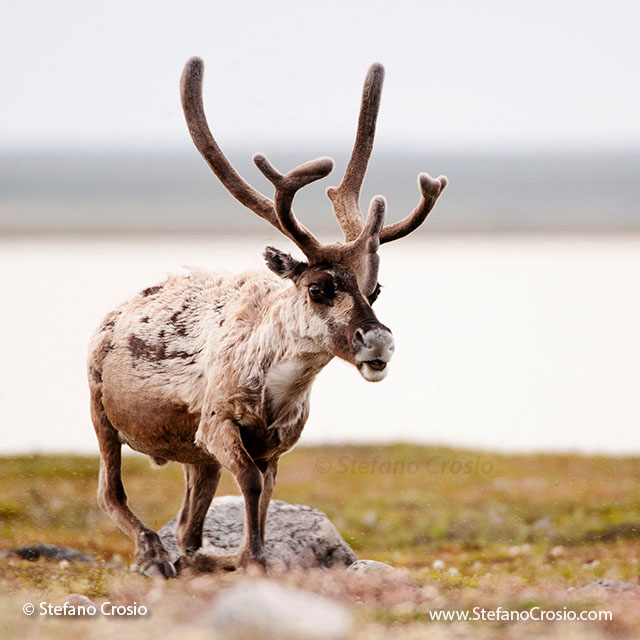
Nikon D300 200 -400mm f/4.0 f/5,6 1/500 Iso 640 550mm
Canada, Nunavut: Barren-ground caribou (Rangifer tarandus groenlandicus) bull
_____________________________________________________________
About Stefano
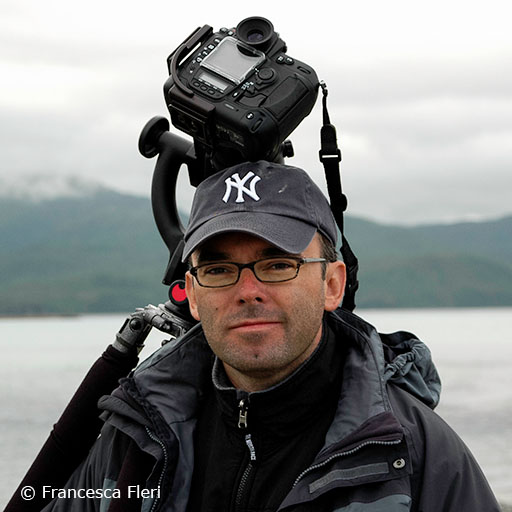
Nikon D70 28 -105mm f/3.5-4.5 f/5,6 1/640 Iso 400 62mm
Myself 🙂
I am a photographer based in Connecticut, USA. I focus mostly on nature & wildlife photography as well as food photography, along with occasional portraiture shoots. My Web site is at www.StefanoCrosio.com and my photography (and wine!) blog is at www.ClicksAndCorks.com. I also contribute the food photography and wine-related posts to Flora’s Table, an Italian cooking and fine wining blog at www.florastable.com While a photographer needs to possess a solid command of the technical aspects of photography, I think what really differentiates a photographer as an artist from a mere camera operator is vision, creativity and compositional skills. Personally, the photographers who inspired me and motivated me to pursue nature and wildlife photography were the late Galen Rowell and Art Wolfe, both of whom I had the privilege to personally meet and learn from.
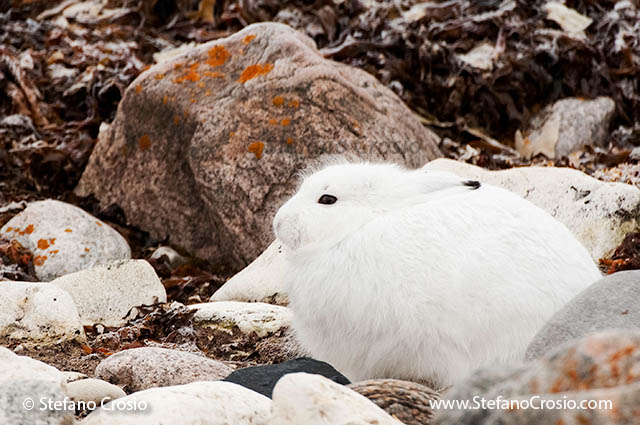
Nikon D2x 200 -400mm f/4.0 f/5,6 1/100 Iso 400 490mm
Canada, Hudson Bay: Arctic hare (Lepus arcticus) in winter coat
What inspires me is the very core element of photography: light, in its endless, ever-changing qualities, be it natural or artificial. I love the effort, sometimes the challenge to harness its intensity, to control contrast whenever possible to the best advantage of an image and otherwise to just accept not to take the shot. I strive to create a pleasing interplay between light and shadows, to subtly recreate depth in a 2D medium.
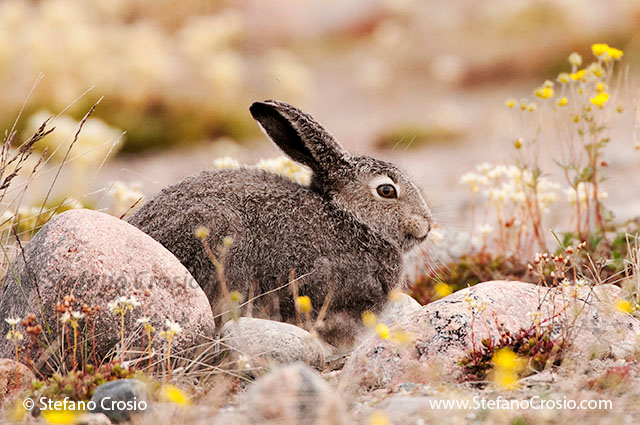
Nikon D300 200 -400mm f/4.0 f/5,6 1/500 Iso 640 550mm
Canada, Nunavut: Arctic hare (Lepus arcticus) in summer coat
In my nature and wildlife work, I strive to tell the story behind every animal that I photograph, to capture those fleeting moments which define the essence of my subjects, to catch a glimpse of their inner selves. My ultimate goal is to produce images that elicit an emotional reaction from their viewers. My work has been published in several U.S. and Italian magazines, as well as in textbooks, corporate brochures, newsletters and Web sites in various countries. My images have also been exhibited in juried shows as well as awarded in national and international photography competitions.
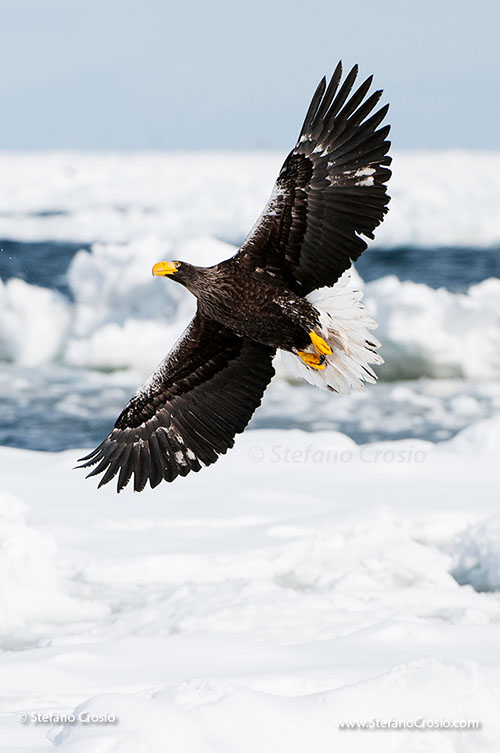
Reblogged this on Bobbi's Blog.
LikeLike
This is GREAT, I just l♥ve being reblogged and I certainly think that Stefano’s fine work deserves it! 🙂 🙂
LikeLike
Thank you for reblogging! 🙂
LikeLike
Fantastic wildlife images. I particularly liked the fox pics especially since I recently discovered a red fox on my property!
LikeLike
Thank you for your kind words: we have a red fox that sometimes comes by our property too! Beautiful animal.
LikeLike
Raw life
LikeLike
Yes, I guess it is.
LikeLike
very nice set of pictures here!!!!
LikeLike
Thank you!
LikeLike
Shout-Outstanding wildlife photography! This is wonderful, Stefano! They’re all great and unique in their own way, it’s hard to pick a favourite.Thanks for sharing, Dina. Your fav at the top ist gorgeous and the seal…. and the fox …
Have a great weekend everybody.
Hilsen Hjerter ♥
LikeLike
Takk skal du ha! 🙂 Ha en god helg, Hjerter! ♥
LikeLike
Thank you very much, Hjerter! I am thrilled to hear that you liked them. 🙂
A lot of time and effort went into making these images and it is great to see that they elicited a reaction in the viewers.
You have a wonderful weekend too!
LikeLike
Dear Stefano,
I’m sure the images are very precious indeed. Just think about the equipment, the travels, and all the skillls you have obtained and invested in each and every photo that we see, that’s really amazing! Thank you for sharing this and inspiring us.:-)
LikeLike
Amazing photographs. I like the birds best. Just breathing the North (and here I am sitting in the Tropics…)
LikeLike
Thank you for your kind words: well, I have to say that, despite how much I love the Far North, being at the Tropics doesn’t sound too shabby to me!!! 😉
LikeLike
Doens’t sound shabby at all, if you ask me 🙂 🙂
LikeLike
Amazing shots. Really like them. Thank you! Veraiconica
LikeLike
Thank you, glad you liked them.
LikeLike
These are beautiful images of lots of wildlife I’ll never see in person. Dina, thanks for hosting and introducing us to Stefano.
Stefano – thanks for braving the cold for the shots!
LikeLike
Well, I’m very, very proud and most happy to host Stefano and his great work here. I’m glad you like it! 🙂 I’d love to see this with my own eyes. There’s so much to see, so many places on my bucket list and the arctic, nature and wildlife comes top of the list
.
Of course, I’d like to capture the nature myself too, but…. it takes a lot experience, knowledge and camera feeling to produce such outstanding results.
Further down, Jürgen is quoting Galen Rowell, he says it! 🙂
LikeLike
Aaaatchooo!!! 😉 Thank you, Heather, for your kind comment, and glad to hear that you liked them! I really like the Arctic and Subarctic regions, so I have to say I am not that bothered by the cold. As somebody said (it think it was an ad of some outdoor sports brand) “there is no such thing as bad weather, there’s only inadequate clothing” 😉 I think there is some truth to that: if you are well prepared, it is not that bad.
LikeLike
I agree! I am somewhat of a wimp about the cold, but have lots of layers so I spend my northern Michigan winters outside 🙂
Thanks again for sharing!
LikeLike
Northern Michigan winters sound fabulous! How wintery is your region?
LikeLike
Thanks for sharing these wonderful photos, Dina. The focus is amazing (reminds me I must make more effort to unfold that tripod of mine when I go outdoors shooting – I tend to get lazy when I’m getting tired & shoot hand-held).
Love the composition & colour of that first shot.
I’m now going to cross over and view/read some more of Stefano’s work.
LikeLike
Thanks for looking in and commenting! The first one is my fvaourite as well, it went straight to my ♥. Did you see his polar bears… the one cuddling?? 🙂
To be absolutely honest, Victoria; I have two tripods and I have never ever used one! 🙂
LikeLike
Dearest Dina,
you are always too kind: thank you so much again for this fantastic opportunity to showcase my work! 🙂
Big hugs
LikeLike
Thank you for your kind words, Victoria: glad you enjoyed my images. As much as it is an undeniable hindrance, a tripod is really a necessity in many situations (long telephotos, macro work, shooting at the fringes of the day, panoramas, critical framing…) I think investing in a good carbon fiber tripod is money well spent, and the lighter weight may make it easier for you to lug it around. Having said that, there are certainly situations when it is perfectly fine to shoot handheld, especially with VR/IS lenses and such.
LikeLike
My favourite lens for travelling is a Nikon 18-200mm VR II. This is OK to shoot handheld. I’m still using my old D200 body. I was just about to get the D800 then I realized, I’d to update my lenses (thank you Hans!) and now I’m seriously thinking about getting the D7000. Thinking all the time… because I have to decide which way I go now. I want to get a zoom 200-400 and a wideangle. DX or FX? What do you think about the Sigma 11-18mm? Better get the Nikon 12-24mm? Which lenses are working on the D200, D7000 and D800? Sorry about pouring all this questions over you Stefano! We had a similar discusson on another post and I think many amateur photographers are just chewing on the same decisions.
LikeLike
Well, just like you said, decisions, decisions, decisions… 🙂
You are right, Dina: the first thing to decide is FX vs DX. See, when I wanted to replace my D2X, I went through the same decision making process. In essence, I liked the DX format because of the cropping factor that really helps when you are shooting long telephotos without having to sacrifice Megapixels, but I really wanted an FX body to be able to use my wide angles to the full potential, just like in the film days. And then came the D800, which really was the solution to my predicament. Because I had all the benefits of the FX format at whopping 36 MP, and at the same time I was still able to get DX images at 15 MP, which is not bad at all, and especially 6 fps (with the battery grip). On these specs I was totally sold on the camera as for me it was the best of both worlds, and I have to say it went beyond my wildest expectations. 🙂
Having said that, at 36 MP it is a camera that tests your lenses’ resolving power and your shooting technique. While I found all the rumors about not being handholdable baseless (I have gotten razor sharp pictures handholding it), it does require that you properly handhold it and it generally requires faster shutter speeds when handheld. But I have never seen files so “crisp” and so clean and vibrant as those coming out of that camera.
Clearly, when it comes to equipment choices, another important factor is… budget. But based on your skills and on some of the equipment you mentioned, I would assume you are interested in the Nikon pro/semipro lineup.
Regarding long lenses, as you know I have the 200-400 which is a sweet lens and a very flexible one. Now that they came out with the new version, I think you can find some good deal on a used first generation one, which may help as it is as you know an expensive lens. But I would say you would definitely be happy with it.
Speaking of wide angles, I would seriously recommend that you avoid getting a DX one, as I think that (even if this time you decide not to buy the D800) sooner or later you may end up buying an FX camera and you would have to trade it in. Lenses are the most important investment you are going to make in a system, as you will upgrade bodies but good lenses will outlast them. I am still using my Nikkor 28-70 on my D800 and it works like a beauty. If you ask me and if you can justify the cost, get a Nikkor 14-24: it is the sharpest, more contrasty wide angle I have ever shot.
So, if you ask me and of course once again if budget permits, I would go D800 with the battery grip, 14-24 and 200-400. Sure, not inexpensive 🙂 but it would be a killer combo! 🙂
Just my 2 cents! 🙂
Big hugs,
Stefano
LikeLike
Dear Stefano,
with this excellent answer, you are qualified as a Nikon ambassador!! This is immensely helpful for me. I have been asking so many people for advice and depending on how I put the question, I got all sorts of answers. I have honestly spent very long hours on this, but now I’m enlightened and I find it easy to take a decision. It’s like a burden being removed from my shoulders! In fact, I am at a sort of a turning point. Looking back later, I’ll surely think, Stefano guided me into this. 🙂
It’s like the Cheshire Cat asking Alice “where are you going” and she answers; “I don’t know”. If you don’t know where you are going, how can anyone help you on the right track? With your advice, I know I want to upgrade and solely with Nikon products and go for the FX. Do you use a converter for your 200-400mm?
Of course, the budget was my main obstacle. With a decision made, I don’t regard it as a hindrance any longer. I have it on the list and it’s time to do some serious calculating. 🙂
Thanks!!
LikeLike
Dearest Dina,
I am very happy to hear that I have been of some help in yor decision-making process. Believe me, I know it is tough: like I said, I have gone through it myself, and especially when you are talking about investing some serious money into something, it is even more important to research the subject well and to do your best to identify what your objectives and your technical/artistic needs are. After you have done that, I think all becomes clear and it is just a matter of implementation. 🙂
Given your style of photography (based on what I have seen on your and on Klausbernd’s beautiful blogs) and your gift for composition, I think your choice to go FX is the wisest, and like I said it will not prevent you from enjoying the convenience of the DX format when it is needed. I am *positive* that you are going to love your camera and you will have to force yourself to put it down! 🙂
On the 200-400 I occasionally use a 1.4x converter, but only when it is really necessary. It works very well, but of course it raises your maximum aperture wide open by 1 stop to f/5.6, so it is great in good light conditions, but in dimmer light scenarios it means that you will have to sacrifice 1 stop shutter speed (or crank up the ISO by one stop) to achieve the same exposure, and that may not always be ideal. I have been told that people have also been successfully using the 1.7x converter on the 200-400, but in dim light you may find it difficult to AF accurately as the lens may start “hunting” (as you know, Nikon “guarantees” correct AF behavior only on lenses with a maximum aperture wide open of f/5.6 or faster, so with a 1.7x teleconverter on the 200-400 you would be pushing it). The 2x is instead out of the question if you want to retain AF ability as it would raise your wide open aperture to f/8.
I tell you, I am excited for you about these decisions!!! 🙂
Big hug,
Stefano
LikeLike
I’m quite excited myself, in a very happy, quiet mood!
🙂 I don’t know how thank you for this great advice, it’s like a big gift.
Tusen takk for hjelpen1 🙂
LikeLike
Hei Dina, dear Stefano,
that sounds really expensive! The other day I read a most entertaining post about fishing. The lady presented the bill for for the fish, proudly captured by her husband, calculating everything from buying the gear, the clothing, travelling… I don’t even dare to think what each beautiful image in this stunning row of wildlife have actually costed you, Stefano! 😉
But surely, it’s lifestyle, I know. 🙂 Your work is really outstanding.
Have a super new week.
Minna
LikeLike
Dear Minna,
Thank you for your kind comment.
You are right, it is an expensive package (although by buying at least the lenses second hand you may be able to shave a few dollars/euro off). However, I think as it often happens in life you have to have the right tools for the right job. 🙂
I mean, I agree that a “kit” like that to photograph your own kids in the backyard or at a ball game would be kind of ridiculous, but if you want (or have to) go on an expedition whose aim is photographing wildlife, then in my view you should either pass or get the right equipment. Because I think that the significant cost of the expedition itself (if you pay out of your own pocket, but this also holds true if someone else is paying for you in return for an expectation of quality images) would be hardly justified if then you skimp on equipment and cannot get the images you were after because of that.
Unfortunately, wildlife is often wary of us humans and so, in order for you to get good shots, you need long lenses and since many animals tend to be most active at the fringes of the day, when the light is dim, you also need fast lenses (f/2.8 or f/4) which makes them even more expensive – many serious photographers (birders especially) even go through the considerable expense of purchasing 600mm f/4 lenses, which cost a fortune. On top of that, you need a camera (and lenses) that can first of all withstand the elements: when you are in those extreme environments you don’t have cover or anything to protect your gear (or yourself for that matter!), you are out there with your equipment to get the shot and everything’d better work as it should. I have been photographing in torrential rain, in sand storms, in snow storms, my gear has been banged around countless boats, float planes, bush planes, 4x4s, quads, you name it and it has kept working flawlessly as it should. This is one of the more important features that you get by buying pro-grade gear: dependability.
And bear in mind that you do not only have to take into account the cost of the equipment in your calculations of “how much that shot ended up costing”, but also, on the other side, the revenue that you derive from the images you take (in terms of licensing rights, prints and, for some photographers, workshops).
I don’t know, I could go on but I have bored you enough already. 🙂
In the end, it is all a means to an end, I guess: you want/need a certain type of shot? Then you need the right gear to take it home. If you don’t need that, then I absolutely agree, there is plenty of great compact, do-it-all cameras that are wonderful for their intended use. But knowing Dina a little bit, it did not seem to me that casual shooting was what she was after (otherwise her D200 could still suffice, I guess).
Thanks again for your kind comment! 🙂
LikeLike
Hi Minna,
well this is seriously expensive, but you’re right; it’s lifestyle too, a factor not to be underestimated, beside the quality.
I love Nikon and I love the feeling of identifying with this product. I thinks that’s what made my decision so hard as I were playing with the thought of getting cheaper lenses from Sigma oder Tokina.
Nikon; it’s like slipping into the very old and shabby Barbourjacket in Norfolk, it’s the right product for the environment, it looks right and it feels right. 🙂
And… Norfolk is an area out outstanding natural beauty, it’s a birdwatcher’s paradise and when I see the gear the birdwatchers sometimes carry, I find it hard to close my mouth.. 😉
Thanks for visiting, Minna! 🙂
LikeLike
Exquisite..especiay the wolf and the fox… and the hare…oh – actually they’re all beautoful !!!
LikeLike
Yes, Valerie – they are all more, way beyond beautiful! 🙂 I’m so glad, you enjoyed it too!
LikeLike
Thank you very much! 🙂
LikeLike
I like the photos – they have a lot of atmosphere.
I think you need a lot of patience to catch the right moment.
LikeLike
Thank you, Susanne: you said it, patience is certainly something you need in large amounts in wildlife photography. As a tracker once said to an impatient lady in a South African safari, “You know, nature is not a zoo” and it is very true: as much as you would want animals to show up at the perfect time *for you* or to do that cool move in perfect light when you are all set up and ready with just the right gear… well, sometimes you just have to accept that… sigh… you are not God after all and things unfold according to their own plans and schedule and it is you who need to adapt and make the most of every situation under the circumstances. Or sometimes even accept that it is okay to just watch and not take the shot. This is what I have learnt after doing this for a few years, at least! 🙂
LikeLike
An remarkable collection! And lots and lots of adventures…
A reminder that we still have amazingly open spaces where only a few have trod. Thank you for sharing.
LikeLike
So very true: in my view, the only limits to our ability to travel and explore are money, time, and our willingness to sacrifice a bit of those comforts that we have grown accustomed to and push the envelope! 🙂
Thank you for your kind words!
LikeLike
….in my view, the only limits to our ability to travel and explore are money, time, and our willingness to sacrifice a bit of those comforts that we have grown accustomed to and push the envelope!….
Wise words, Stefano.. They’re in my book of quotations now! 🙂
LikeLike
You are too kind, Dina! 🙂
Happy to be on your book though! 😀
LikeLike
Not at all…
Leaving the comfort zone is vital… 🙂
I didn’t know the expression “to push the envelope”, this turns out be very educating indeed. In German this would be; bis an die Grenze gehen.
Your English is amazingly good, absolutely impeccable, Francesca’s obviously too. Thumbs up for the 2 of you!
LikeLike
Wonderful… lovely to follow u … exhilarating
LikeLike
Thank you!
LikeLike
Wow, these are utterly beautiful. What a photographer of genius!
LikeLike
Thank you: far too kind of you! 🙂
LikeLike
Flotte representanter for Nikon dette!
Og her ser en tydelig at det er personen bak kamera som er viktig, – eldre modeller og de fleste i DX format!
LikeLike
Ja, det stemmer, nok en gang! Tusen takk for hjelpen, Hans.
Ha en god helg!
LikeLike
Takk for hyggelige ord, Hans! Jeg elsker arbeidet ditt og har begynt å følge bloggen din.
Now, I am not sure if that makes any sense at all in Norwegian, but it is the best I could do via Google Translate (thank you, Google!) 🙂
LikeLike
I understand, both Norwegian and English….
LikeLike
Amazing photos… 🙂
LikeLike
Thank you!
LikeLike
Den Fotografen würde ich sehr gern mit meiner kleinen Kamera begleiten in der Hoffnung, auch ein oder zwei Tiere zu sehen. Was für ein Abenteuer.
Liebe Grüße
magdalena
LikeLike
Iiiiic auch, ich auch! 🙂
Me too, I’d also like to come along on an expedition and learn from Stefano! 🙂
That’d be the right adventure. 🙂
Hoep you’re feeling better all the time Magdalena. You have many adventures in front of you!
Big hug! ♥ Enjoy your Weekend.
Dina
LikeLike
Thank you both for your very kind words: who knows, maybe at some point we could even make that happen! There’s no shortage of fantastic places to travel to and still enough wildlife to observe and photograph! 🙂
LikeLike
Liebe Dina, das Angebot von Stefano sollten wir uns nicht entgehen lassen.
♥♥♥
LikeLike
AUF GAR KEINEN FALL.
♥♥♥
We’re taking your word on that one, Stefano, you can count on us!
LikeLike
Thank you both for your kind words: I will most definitely think about it – please stay tuned! 🙂
LikeLike
ommoidio, che meraviglia!!!!!
oh, no, io devo accontentarmi per i grandi viaggi di farli attraverso grandi immagini di grandi fotografi come tu lo sei…ed è infinitamente emozionante anche così
grazie a te ed
danche a Dina che ho da poco conosciuta come blogger , che ti ospita
evvvaiiii Stefanoooo
LikeLike
I don’t understand this, but I’m sure it’s nice! Takk skal du ha, mille grazie! 🙂
LikeLike
Yes, it is a very nice comment from an Italian woman who hosts an interesting poetry blog and has recently started following yours. 🙂
LikeLike
Mille grazie, once again.
LikeLike
Grazie mille per il tuo commento! Sei una gentilissima ed abile poeta! 🙂 Le hai scattate tu le immagini sul tuo blog? Sono bellissime!
And yes, Dina and her blog really rock! 🙂
LikeLike
Non tutte Stefano, solo alcune, non sono così brava, quelle che non sono mie le scelgo con cura sul web ma sono innamorata dell’arte della fotografia e so riconoscere chi ha grandi capacità, e mi emoziono moltissimo, spesso queste m’ispirano i miei piccoli testi, ti ringrazio tanto per la bella accoglienza, sei una persona squisita e gentile, e sono felice di parlarti in italiano, ma per omaggio alla tua ospite tradurrò anche in inglese,
a presto
Ventis
Not all, but some are not so good, those that are not mine the choose with care on the web but are in love with the art of photography and I know recognize who has great ability, and I still get emotional, very often these inspire me my little text, thank you so much for the Nice welcome, you are exquisite and gentle person, and I’m happy to talk to you in Italianbut for tribute to your host will translate in English,
See you soon
Ventis
LikeLike
Reblogged this on Svalbardpost and commented:
Did you see Stefano’s stunning images from Alaska on kbvollmarblog, in the post about James Michener? Dina is presenting his big variety in wildlife photography right now. Amazing captures of animals and nature in areas I am not familiar with:
LikeLike
Takk skal du ha, Per Magnus! 🙂
Thanks a lot reblogging us! 🙂
Klem fra meg til deg
Hanne
LikeLike
Dear Per Magnus,
Let me join Dina in thanking you for the reblog and for your very kind words!
Glad you liked my images! 🙂
LikeLike
Dear Stefano,
like Magdalena writes, I’d very much like to join you on a trip, hoping to see animals I’ve never seen before! You’d be the right man behind the camera and we could learn how to capture a story, not just to frame a scene. Excellent job.
Greetings to you from the Far North in Longyearbyen
Per Magnus
LikeLike
Dear Per Magnus,
First off, thank you for your most kind words and offer. As I alluded to in passing in response to Magdalena’s comment, focused photo workshops/mini-expeditions are something that I have been looking into for a while, and it is possible that at some point I will offer one or two. A lot of preparation needs to go into it, especially because I have a concept in mind that I would like my workshops to revolve around, so that they are perceived by participants as a really great photography and wildlife learning experience. I would love going photographing together with you – I am sure it would be a lot of fun and a great adventure!
Also, Svalbard (along with its polar bears, birds and Northern Lights!) has been very high on my places-to-go-to list for a while now, so at some point I may actually reach out to you and bother you for a few tips in terms of how to best organize a photographic trip to your beautiful island. Oh, and is it true that Longyear City 🙂 has a restaurant with one of the largest wine cellars in Europe?!? That would certainly be yet another great attraction to me! 😀
All the very best,
Stefano
LikeLike
Dear Stefano,
thank you very, very much. I feel honoured about your idea but it`s unfortunately wrong timing. As Klausbernd mentioned the “rumor” in his comment it`s right that will leave Svalbard probably already at the end of July. I will go back to my home town Bergen and then I will accept a work in Germany – in the Weimar where my son is studying now. I am very sorry about this because I really would like to take on your offer.
For a real wildlife adventure you probably would need to go by ship. I talked to Klausbernd about it when he went. Going overland is not only a risk but you need a guide and how shall I put it? You have to be tough. I think such a workshop you have in mind is best done on a ship with excursions. And to be open, Longyearbyen is a boring place (therefore I will leave) and not the best starting point for wildlife photography and (another reason why I will leave) it`s unbelievably expensive. Drinking alcohol costs a fortune. Although I was paid quite well I couldn`t afford to drink wine, well, only to very, very special occasions.
Who knows quite a lot about this Arctic region is Klausbernd but he is not a guide. I learned quite a lot from talks with him about perception and projection, about “seeing” in the Arctic. He knows a guide, the one he went with.
Sorry that I can`t be of more help.
I wish you luck.
All the best
Per Magnus
LikeLike
Dear Per Magnus,
Thank you very much for your reply and information.
I am happy for you that you will have the opportunity to reunite with your son. Also, let me tell you that I carry Bergen as a treasured memory in my heart: I had been there for a few days years ago, when I was in law school, with not much cash in my pocket 🙂 but I have the fondest memories of that beautiful town and the fabulous fish market at the harbor. I think I ate there the best smoked salmon I have ever tasted in my life! 🙂
Also, thank you very much for all your precious tips and information: you have already been of tremendous help! I guess I will talk about this trip more with Klausbernd when the time comes to start preparing it.
Once again, many thanks for taking the time to write so thorough a reply and best wishes for your forthcoming new adventure!
All the best,
Stefano
LikeLike
🙂 🙂 Typical for beerdrinking Norwegians to overead this question about wine! 😉
Actually, I know for a fact that Per Magnus likes wine a lot and of course he knows the place you mentioned, “Huset”, it’s one of the best and biggest (20.000 bottles) winecellars in the whole of Northern Europe. Ever since 2006 it becomes the Best of Award of Excellence from the Wine Spectator. Reason good enough to go, isn’t it? 🙂
http://www.huset.com/vinkjeller-67-67/
I love this appearance: when you klick home, there comes a warning: be aware of the polar bears!
http://www.huset.com/
LikeLike
Wow, Dina: most impressive – just the bottle of the Grand Vin de Chateau Latour on the home page of the restaurant gives you an idea of the level of its wine cellar! Certainly, as Per Magnus hinted at, I don’t even want to think about the prices they are going to charge for those bottles!!! 🙂 Even so, just like you said, plenty good reason enough for going (plus a few polar bears and Northern Light displays, of course)!!! 🙂
LikeLike
Thank you so much for sharing, the fotos are awesome!
LikeLike
Thank you for looking! 🙂
LikeLike
Terrific set of nature images, thanks.
LikeLike
Thank you for your kind words!
LikeLike
GREAT wildlife photography, I am speechless 😉 Thank you very much for sharing. I suppose you need a lot of patience to get such shots.
This is an area I would like to go to with Dina and our Booksfayries as well.
And now I know how you look like 🙂
Thank you for showing your pictures here!
Big hugs to you and Francesca
Klausbernd
LikeLike
I’d love to go there too!! 🙂
Dina ♥
LikeLike
Thank you very much for your very kind words, Klausbernd! 🙂
As I mentioned in response to Susanne’s comment above, patience is definitely key in wildlife photography, as you never know exactly when things are going to unfold or when action is going to happen. Sure, knowledge of the subject helps capitalize on opportunities, but then it is all up to nature whether things are going to work out photographically or not! I think in a way wildlife photography makes you learn self-discipline and the ability to accept whatever fate sends your way 🙂
Both Northern Canada and Hokkaido are places that, in my view, are definitely worth a photographic trip. I think you guys would love it up there.
And yes, the mystery is now over: I am no longer a faceless man! 😉
Thank you very much to Dina once again for hosting me on her wonderful blog!
Big hugs right back at you, Dina and the Bookfayries!
Stefano
LikeLike
Amazing pictures! North of the Wall seems interesting! 🙂
LikeLike
Thank you! And yes, North of the Wall is way cool! 😉
LikeLike
Lucky you, to have worked with Galen Rowell, Stefano!
“A lot of people think that when you have grand scenery, such as you have in Yosemite, that photography must be easy.” – Galen Rowell
I think this quote sums it up pretty good. It takes a lot of skill to capture wildlife like this, it’s not just a matter of going North! This is seriously good!
Greetings from Frankfurt
Jürgen
LikeLike
Thank you very much for your kind words and for the excellent quote, Jurgen!
Galen was absolutely right: actually, going out to photograph super famous locations that have been photographed a billion times before is actually way harder than photographing relatively obscure places, where there are not that many reference points. Those famous places force the serious photographer to challenge him/herself even more and to push the envelope in terms of creativity in an effort to come up with a fresher perspective of those icons, with something that looks refreshingly different from the billion images out there that kind of look all the same. This is why you kind of get to smile when you see scores of photographers who line up to set up their tripods in the very same spot where Ansel Adams’s tripod legs were at the Snake River overlook to “take the same shot”. I think they would be better off if they challenged themselves to come up with *their own* interpretation of that scene, instead of trying to replicate Ansel’s image.
And yes, getting to learn from Galen and even more so getting to know him in person was a wonderful experience that I will forever keep in my memories. Such a fantastically gifted photographer, great mountaineer and athlete and yet such a shy, humble, no nonsense man. He set a great example for many of us.
Apologies for my ramblings and the very long reply! 🙂
All the best,
Stefano
LikeLike
Thank you very, very much for this long and very interesting answer, Stefano! I looked at Anselm Adam’s Snake River and read the story behind so many shots being made at this point every day, this is really amazing! 🙂 What a grand feeling it must be; to be the person behind such a famous Image. Very impressive.
…”I think they would be better off if they challenged themselves to come up with *their own* Interpretation”….
I’m not blogging myself, well I am now, aren’t I? – but I occassionally read a few blogs and I follow Dina and we have been discussing this matter more than one time: Instagram, Facebook , millions of blogs etc are pouring out images like a giant landslide, please forgive me everyone!… 🙂 and if you dare look at the great ones, the recipe seem to be quite simple: Less is more! I think that makes the brilliant shots even better. We know there are maybe a hundred other shots, sometimes a lot more, that have been rejected. But the good photographer doesn’t bother us with all of them, he only shows us the best. and tells us a good story.
It was a pleasure to get to know you Stefano, keep up the good work and enjoy your weekend!
Jürgen
LikeLike
Thank you, Jurgen, for sharing your perspective and for articulating it so well.
I also think that, especially in photography, less is way more. And I think this holds true both, just like you said, in terms of the number of images that you as a photographer are going to put out there “for the world to see” and also in terms of what is in your photograph.
Someone (in my view perfectly) once said that the core of photography is putting order out of chaos: it sounds a bit masonic 😉 but I think it is absolutely right.
One of the biggest challenges for a photographer is, if you will, to distill the scene in front of him/her to its essential elements, to leave out all the superfluous and distracting parts, to simplify the scene in the viewfinder to the core of the message that you as the photographer want to convey to the viewers. Only by following this process will you be able to actually achieve images that communicate by themselves, that tell the story with no need for words.
I remember when Galen Rowell back in the days of film used to critique our images, he would project the slides on the wall and then move around with two rulers connected at a 90 degree angle on one end and he would tell us: “okay, there is an image in here, let’s find it by removing all the unnecessary information” and he would find what he knew that it was the core element that each of us wanted to photograph. By blocking out all the distracting elements that we had included in our images, he showed us so vividly how much more of a powerful photograph it would become by simplifying its content as he suggested. Art Wolfe, who is another master in communication and simplification, also follows a similar approach. I think it is one of the most incredibly helpful ways to be taught how to see photographically.
Dear Jurgen, I apologize for my ramblings and the very long, winding reply to your comment, but you inspired me to share this experience! 🙂
It has been a pleasure meeting you too, if only “electronically” 🙂
All the best,
Stefano
LikeLike
Thank you very, very much for this fascinating reply, Stefano! You sure sound like you’d be a briiliant supervisor and coach yourself! You live and breathe what you burn for and you make it sound so easy, well relatively speaking, of course. 🙂
Did you at one time in the past have an encounter or an experience that was the turningpoint for you as a photographer? You’re not a fulltime photographer, are you?
It’d like to share a very, vey nice bottle of wine with you and talk and dream about the small and big things in life. 🙂
All the best,
Jürgen
LikeLike
Dear Jurgen,
Thank you for the engaging and stimulating conversation! 🙂
And thank you for your kind words: I wish I had 10% of the vision and genius of masters like Galen Rowell, Art Wolfe, Frans Lanting or, in the portraiture field, Steve McCurry! :-). However, you are absolutely right saying that I am really fascinated by photography in general and nature/wildlife and portrait photography in particular as I find it extraordinary to be able to convey visually a message, to reveal a glimpse of your subject’s inner self, to create an emotional reaction in your viewers by mastering a medium that mixes technical mastery with artistic vision.
I am not a full-time photographer – or at least I am not until National Geographic discovers me 😉 😉 There definitely was a turning point, a moment when the “photography fever” took me, and that was in 1999 when I read “Mountain Light” by Galen and I was awestruck by his images and the philosophy behind them. I started studying a number of photography books to learn the technical aspects of photography, among which those from which I learned the most were the entire series of John Shaw’s books, and then I signed up for a workshop with Galen in 2002 (back then I was in Rome and I flew all the way to the Sierra Nevada in California just to attend that workshop and get to know the man!) This was just three months before his untimely death, and I was completely in awe with that man: such a world famous photographer and mountaineer and yet such an unassuming, down to earth person. And then I kept learning from other photographers that I felt inspired by and I improved until I started publishing my first images, and so on…
Dear Jurgen, I totally reciprocate your wish to sit down together in front of a nice bottle of wine and talk about life in general and its sometimes unexpected turns, kind of like in Sliding Doors (the movie)… Should you ever come this side of the pond, on the northeastern coast of the US and have some spare time, please let me know and I will do the same should I go to Frankfurt.
All the best and thank you once again for this very pleasant conversation 🙂
Stefano
LikeLike
His.pictures are amazing:)
LikeLike
Thank you very much! Glad you liked them! 🙂
LikeLike
Great shots! Interesting to study the capture Information, thanks for providing the metadata. Which camera do you mostly use today?
Are you a Nikon ambassador, like Hans and Roy?
LikeLike
Dear Petra,
Thank you for your kind words and your questions.
Nowadays I mostly use a Nikon D800 (which I totally love) and I still use my D300 as my second body.
And no, I am not a Nikon Ambassador: honestly I have never really looked into it, but as I understand it, I think you need to be invited by Nikon to become one, and Nikon has not extended that invitation to me (yet???) 😉
LikeLike
Amazing shots! Thank you for the post and introducing Stefano!
LikeLike
Thank you very much, Amy! 🙂
LikeLike
Stunning wildlife and naturephotos! Love them all!
LikeLike
Thank you, Sofia: glad you liked them – appreciate your comment 🙂
LikeLike
Yes wonderful, congrats Stefano 😀
LikeLike
Fabulous images. White-tailed sea eagles were extinct in Scotland but have successfully been reintroduced. They are quite amazing to watch.
LikeLike
Thank you for your kind words. Yes, white-tailed sea eagles are beautiful and powerful birds: having an opportunity to spend some time photographing when there’s many of them hovering all around you and interacting with Steller’s sea eagles was an amazing treat!
LikeLike
Gorgeous photos! Thanks.
janet
LikeLike
Thank you for your kind words, Janet!
LikeLike
You take beautiful pictures.
LikeLike
Thank you, glad you liked them! 🙂
LikeLike
Wonderful – nature, photography, everything. Thank you so much for introducing us to this!
LikeLike
Thank you! Glad you enjoyed the images and the post! 🙂
LikeLike
These are amazing photographs. Take a bow Stefano. 😉
LikeLike
Thank you very much, B: now I’m kind of blushing… 🙂
I am happy that you liked them.
LikeLike
Besonders das Foto wo er dieKamera auf dem Kopf hat und so relaxted und zufrieden guckt gefällt mir 🙂
LikeLike
🙂 🙂
I actually think it’s vital to see the blogger I’m corresponding with. There’re lots of bloggers out there prefering to be anonymous. They don’t give away a name nor a photo.
If you want to better than the rest and especially as a photographer I think it’s ESSENTIAL to have a pofessional self portrait. One that match your brand and your personality. I think Stefano picked a great shot, thank you Francesca! 🙂 ♥
A photo like this helps the readers feel welcome, doesn’t it? A photographer has to appear trustworthy and approachable and the right photo helps a lot.
Or what do you think?
LikeLike
Ich glaube, da ist was schiiief gelaufen…. LG
LikeLike
An amazing and inspiring collection — reflects the stunning richness and diversity of our natural world. Thank you for showcasing Stefano’s work, Dina.
LikeLike
You are very welcome, Kat. Thanks a lot for visiting and your kind words. It’s a pleasure and a privilige hosting Stefano.
LikeLike
Thank you very much for your kind words: that was exactly the idea that Dina and I had for this series – showcasing the abundance and diversity of living things there are in the Arctic and Subarctic regions of the world. Glad you liked them! 🙂
LikeLike
I don’t have the patience or the skill for this kind of work (not to mention an abiding dislike of the cold 🙂 ) but I am in awe of these photos. You have the animals speaking. And that caribou sunset- genius! I’m so glad Dina focused me in your direction.
LikeLike
Thank you, Johanna!
…you have the animals speaking… That’s right! 🙂 . I can watch them over and over again, wondering what they’re thinking and communicating.
Thanks for looking this way – have a lovely Sunday!
LikeLike
Thank you very much for your kind words! I am so glad to hear that my images managed to convey to you the emotional reaction that I was seeking.
I think that in wildlife photography the key is capturing that fleeting moment, that glimpse of your subject, that instant when it turns to you and reveals its inner self: it is not easy and it requires a lot of patience, but when it all comes together, then I believe your image speaks for itself.
LikeLike
The White-tailed sea eagle with fish in flight might be definition of the contemporary society itself…This is much more than nature photography!!!! Bravo Stefano! and long live Dina, as she had this idea of presenting his work…!
LikeLike
Bene. Well that was not exactly what I wanted to express, but anyway…at loss for words.. 😉
You put a big, big smile on my face with your lovely comment, benvenutocellini! It’s so nice to have you around… please come back soon! 🙂
We’re planning a trip to the south of Tuscany next June, let’s have coffee together, ok?
♥♥♥
LikeLike
this is Dina or Stefano answering?? Tuscany? where and when exactly??, Dina can write me via mail…. My comment was about perception & interpretation…the photo i was talking about is extremely expressive…so, it can be interpreted… that’s why i dare saying certain things…
Have a nice Sunday!
LikeLike
@benvenutocellini
Sorry, sorry my fault! 😉 it was me, Dina answering, (tooo tired Zzzzzzz working long nights, I was not thinking about the image)
I think your definition of the Eagle with the fish is really great and I’m sure Stefano will be truly delghted to read it. Of course his photography is a lot more than just looking at images.
Thank you! 🙂 ♥ I have answered your mail.;-)
LikeLike
Thank you so much for your kind words! I am so glad to hear that my image elicited an emotional reaction in you, even at a metaphorical level. Thank you! 🙂
LikeLike
Great !!
LikeLike
Thanks! 🙂
LikeLike
Double thanks! 😉
LikeLike
ein außerordentlicher Tierfotograf, ganz sicherlich!
LikeLike
Gewiss. Ganz sicher. Ich danke dir für den Besuch, Frizztext.
LikeLike
Simply stunning images, I look forward to looking through the blog with more time. Beautiful. Thank you for sharing.
LikeLike
Appreciate your visit and kind words, Jo. Have a lovely Sunday!
LikeLike
Thank you very much: glad you liked them! 🙂
LikeLike
Fantastiske bilder/Fantastic pictures!
LikeLike
Takk for besöket ditt, Silje Therese. Ha en god helg!
LikeLike
Thank you very much! 🙂
LikeLike
Outstanding images! RH
LikeLike
Indeed! 🙂
LikeLike
Thank you so much! 🙂
LikeLike
Awesome shots !
LikeLike
Thank you so much!
LikeLike
Thank you very much! 🙂
LikeLike
my pleasure
LikeLike
This may seem odd to some, but as much as I love the animal shots, I am most attracted to the Tundra Lichen shot. 😉 Beautiful stuff.
LikeLike
Thank you, Paula: nothing odd about it – everyone of us reacts instinctively to what he or she is most attuned to or communicates the most to his or her inner self. I think in your case this could be the geometry of the lines in the image, or the color contrast or the different textures… or all those elements combined! 🙂 Thank you for your very kind comment and glad that you liked my images.
LikeLike
Brilliant pictures.
LikeLike
I agree.
LikeLike
Thank you very much! 🙂
LikeLike
Stunning images and interesting narrative. Thank you for this very special post.
LikeLike
Thank you for your kind words! I am glad you enjoyed what you read and looked at! 🙂
LikeLike
Amazing photos! Cheers from Hawaii.
LikeLike
Thank you very much! I hope I will be able to come visit the beautiful islands that you call home sometime soon! 🙂
LikeLike
The opportunities you are having for photography are amazing…just like your art.
LikeLike
Thank you very much for your very kind words! 🙂
LikeLike
Thank you so much for introducing Stefano and his work, Dina! This is a pure delight.
It’s been quite educating for me to read the post and especially the comments, thanks! Even if photography is not for me, the philosophy you are practising sounds right and convincing. “Ordnung ist das halbe Leben” wie die Deutschen sagen. Klausbernd loves Ordnung too.
I don’t want to sound too nosy… but 🙂 if I get this right, you’re a lawyer, sommelier and a photographer, a very good one; what are you doing for a living? Or are you one of the modern, very gifted and talented supermen that loves multitasking?? 🙂 🙂
Greetings from sunny Stockholm
Annalena
LikeLike
Dear Annalena,
Thank you for your very kind comment! I think the love for ordnung (beside photography) comes with certain types of character (I am certainly one of those!) but I think Klausbernd could explain this philosophically much better than I 🙂
And yes, your research is accurate 😉 I am a three-for-one package, one of those you find in supermarkets 😉 Let’s say that I derive most of my income from the lawyering thing 😉 and some from photography – the sommelier part is for my enjoyment, but you never know what the future has in store, so I diversify to hedge myself! 🙂
And Annalena, believe me, I am anything but superman! 🙂 Also, you know that it is a well known notion that only women can multitask, men can only do one thing at a time (if that!) and I am definitely no exception! 😀
Thanks again for your comment: it has been nice “talking” to you, Buchdame! 🙂
Stefano
LikeLike
Oh dear, Annalena,
now everyone knows that I love order, and the Germans who love order … I will not follow that line. But I believe in anything outstanding you do you need quite some order otherwise it becomes chaotic rather than creative. Order means for me finding the best possible form in which you present something. Well, what means “best”? Probably in wildlife photography as in writing the form which shows the typical and which responds at the same time with horizon of exspectation of the receiver. Ideally it would just change that horizon such a bit that it`s still understandable. That`s what we call interesting – if it fullfills the exspectations it`s kitschy. And I think all this is a matter of order – order in the imagination of the producer of the picture, order of the organisation to get there where you are able to take such pics and order of the elements in the picture itself.
Oh dear, Annalena, I know what you mean: typical me. Sorry!
Greetings to Stockholm. Lots of love and I am off for a holiday tomorrow – unorderly 😉
A big hug
Klausbernd
LikeLike
Very impressive images. It’s really amazing what full dedication in naturephotography can achieve. Congrats! Very fine!
LikeLike
Thank you very much for your kind words, Christian! Glad you liked the images 🙂
LikeLike
Absolutely amazing! What a treat 🙂 Thank you!
LikeLike
Thank you very much! 🙂
LikeLike
Amazingly beautiful!
LikeLike
Thank you so much! 🙂
LikeLike
Thank you so much, Karen. I adore your beautiful art.
LikeLike
Überwältigend schön! Der Hammer.
The best I have seen for a long, long time. And I have seen a lot.
LikeLike
Ganz, ganz ♥-lichen Dank für den Besuch, Rainer!:-)
LikeLike
Thank you very much for your very kind words, Rainer: much appreciated! 🙂
LikeLike
These photos are excellent.
LikeLike
Thank you! 🙂
LikeLike
WOW … what a treat for my tired soul 🙂 the nature keeps calling me to unknown places and increases my urge for exploring. You are such a beautiful person Dina for sharing these lens wonders with us. ❤
LikeLike
Thank you: glad my images put a smile on your face and inspired you to explore new places 🙂
LikeLike
Thank you, Paula!♥ 🙂
Big *hug* coming your way…
LikeLike
Hehe, “North of the Wall”, I love your reference! 😀
LikeLike
Thank you! I *love* Game of Thrones! 🙂
LikeLike
Are you watching “North of the Wall” in Oslo?? 🙂 I’ll have a look next month then.
I’m no good at TV, I must admit, I don’t know the channel.
(Psss… Klausbernd doesn’t even have a TV, you know, this intellectual image that you have to keep….don’t tell anyone ..)
LikeLike
Eh, my dear, you break all my secrets 😉
I have never had a TV and I don`t miss it. All my neighbours except one don`t have a TV either. I have books and lots of films on DVD.
Anyway …
Wait until we see each other tomorrow … 😉
Love
Kb xxxx
LikeLike
🙂
LikeLike
Meine Lieblinge, dear Dina and Stefano
this is so beautiful!!! GREAT work. Norway is waiting!
You just have to come to Norge and see Lofoten, Runde and everything North of the Arctic Circle including Svalbard.
The midnight sun in the summer and northern lights and polar bears in wintertime. I know, Dina and Klausbernd are chewing on how to get a sponsor for a trip like this, with you on board they’re almost there, or what do you think? Hehehe 🙂 🙂
Sunny greetings, hugs and kisses to you all from Dina’s hometown Fredrikstad!
LikeLike
Hei Tonemor,
I’d love to go North right away. 🙂 It’s boiling hot in Bonn at the moment, 42°C, puuuuh…
Thanks for for your ♥ comment and helping with some sponsorship, Tone, we’re still chewing. on it! 🙂
Have to pack and get ready for England now, have been very busy in the clinic the last days, I mailed you. ♥
Say hello to the boys from me.
Bis hug, kisses and sunshine for you!:-)
Dina
LikeLike
Thank you very much for your very kind words and for the invitation! 🙂
Norway (Svalbard and perhaps Lofoten) is high up on my places to go to list and I can’t wait to make it happen. I wish that my presence alone were such as to simplify Dina and Klausbernd’s funding hunt!!! 🙂
Big hugs right back at you from the northeastern coast of the Continent that the Vikings visited first! 🙂
LikeLike
Dear Tone,
yes, I would go to the North of Norway right away 🙂
Loveand a big hug
Klausbernd
LikeLike
Let us go soon.
LikeLike
An AMAZING post! Thank you!
Arlen
LikeLike
Thank you very much! Glad you liked it, Arlen! 🙂
LikeLike
Pingback: Juvenile White-Tailed Sea Eagle in Flight… and The World According to Dina! | Clicks & Corks
Stunning!
LikeLike
Thank you very much! 🙂
LikeLike
Thanks a lot for your shout out, Stefano! 🙂
http://clicksandcorks.com/2013/06/19/juvenile-white-tailed-sea-eagle-in-flight-and-the-world-according-to-dina/
LikeLike
Thank *you* very much, dear Dina, for so graciously hosting me on your wonderful blog! This has been fantastic! 🙂
LikeLike
If this post doesn’t win you more followers, I don’t know what will. Beautifully done, Stefano.
LikeLike
Heheheh, thank you for your kind words, John, and for your continued support, which (I want to make sure you know) is greatly appreciated.
LikeLike
🙂 Dear Stefano, it’s more than anything I dreamt of. 🙂 🙂 And it has opened a few magic doors for me! This is great, this is so good! 🙂 🙂
We’re off on a short holiday, thanks a lot for everything so Far…
Take care.
Big *hug* and lots of love to the 3 of you
Dina
LikeLike
Dear Dina, I am so glad to hear that you are happy with the outcome of our little project! And even better that it someway helped you: that is just wonderful! Enjoy your holiday and lots of love back to the four of you! Stefano
LikeLike
Dear Stefano,
this is so beautiful and you are doing so well, better than anyone else – really if I could, I’d give you just as many likes***** as there are flowers in the gardens of Sissinghurst Castle. My sister and myself love your wildlifeliving, you have given us plenty of inspiration. And Dina even more.
Do you know that I have my own little Nikifee, that I’m Dina’s little Knipsi-assistent? It’s a mini Nikon, just right for photographically anything in the fayrieworld of small creatures.
Can you do us a favour, dear Stefano? Can you please take care of this blog until we get to Norfolk at the end of the month? We are all packed and ready to go England now. “You’re rocking our nordic blog”, we’d like to leave with your presentation on top for the next ten days.
I’m very much looking forward to your professional assistance when we go photo hunting for polar bear shots! One fine day…
Fayriedust, hugs and kisses ######
Selma
LikeLike
Dear Selma,
Thank you for your lovely comment and kind words: I am glad if my images turned out to be a source of inspiration for you and Siri! Inspiration is always a good thing! 🙂
I didn’t know that you were also a Nikon photographer – do you use a DSLR or a Coolpix, if I may ask? Now I look forward to seeing a few images of yours! 🙂
And of course I will be more than happy to keep monitoring this post in case there should be new comments etc. while you guys are away! I am very honored by your decision to leave this post on your wonderful blog’s homepage for so long! Thank you! 🙂
Photographing polar bears is a wonderful photo adventure, if it is organized in a safe way (while with the proper knowledge and precautions you can get fairly close to most bears, with these guys it is a completely different story: in spite of how cute and fluffy they look, they are constantly hungry and unfortunately not very selective at all – you have to be real careful). I look forward to that!
A big hug,
Stefano
LikeLike
Dear Stefano,
a big thank you from me too!
####################
Siri Bookfyarie
LikeLike
Thank *you* dear Siri! 🙂
Ciao!
Stefano
LikeLike
Dina, this was a lovely post, thank you for hosting it on your blog.
LikeLike
It was a great pleasure.
LikeLike
Thank you for reading and looking! 🙂
LikeLike
What a wonderful collection!! Dina, you definitely picked the right guy…and Stefano: GREAT, GREAT job. As always. I find myself staring at these photos, immersing myself.
LikeLike
♥-lichen Dank, lieber Winegetter! 🙂
I’m really glad you enjoyed it. It’s quite some work behind it, putting the photos together, if you look at Stefano’s new gallery, you get a faint idea. 😉 Yes, he’s good, indeed!
I love quotes. Allow me to quote Steve Jobs, I think his words are defining the works of Stefano pretty well:
“Your work is going to fill a large part of your life, and the only way to be truly satisfied is to do what you believe is great work. And the only way to do great work is to love what you do. If you haven’t found it yet, keep looking. Don’t settle.”
One more:
“When you’re a carpenter making a beautiful chest of drawers, you’re not going to use a piece of plywood on the back, even though it faces the wall and nobody will ever see it. You’ll know it’s there, so you’re going to use a beautiful piece of wood on the back. For you to sleep well at night, the aesthetic, the quality, has to be carried all the way through.”
Hab’ lieben Dank für den feinen Kommentar, Winegetter!
Stefano wird sich freuen.
LikeLike
Haha, Dina! Thanks for these citations, they definitely hit the nail on the head. I am more for “in der Kürze liegt die Würze”, but that’s the beauty of blogging – all sorts of characters coming together! 😀
LikeLike
Dear Dina,
You know that that graduation speech that Steve Jobs gave is one of my favorite, most inspirational sources for meaningful quotes ever?!? I am so glad you quoted him. There is so much wisdom and inspiration in packed in those few paragraphs, unbelievable.
Two of my favorite ones (beside those that you already quoted) are: “you can’t connect the dots looking forward; you can only connect them looking backwards. So you have to trust that the dots will somehow connect in your future” and “Your time is limited, so don’t waste it living someone else’s life. Don’t be trapped by dogma — which is living with the results of other people’s thinking. Don’t let the noise of others’ opinions drown out your own inner voice. And most important, have the courage to follow your heart and intuition. They somehow already know what you truly want to become. Everything else is secondary.”
🙂
LikeLike
@ Winegetter
🙂 🙂 You’re absolutely right!
Your quote put a big smile on my face! 🙂
@ Stefano,
I love quoting Steve Jobs! Your last quote is pinned on the inside of a cupboard door back home, I find it very inspiring indeed. Many years ago I attended a 5 days WS with Anthony Robbins, he had the same impact on me. It’s great and so stimulating to meet people that encourage one to become the best one can be.
LikeLike
Thank you, Oliver: thank you for “making the trip” to Dina’s beautiful blog and for taking the time to look at my images! 🙂
LikeLike
Absolutely stunning shots – they transport me to the site. Thank you!
LikeLike
Thank you very much: glad you liked them! 🙂
LikeLike
GENIUS!!!
LikeLike
Far too kind of you, but thank you very much! I am glad you enjoyed my images 🙂
LikeLike
Wow, what a gift to share this extraordinary talent. Thank you.
LikeLike
Thank you very much for your very kind words! Glad you enjoyed this photographic trip to the Far North! 🙂
LikeLike
Great photos!
LikeLike
Thank you very much: glad you liked them! 🙂
LikeLike
Those are outstanding wildlife photos by Stefano Crosio. Very talented I must say. May favourite is the one of the polar bears, a beautiful high key with a very dynamic composition.
LikeLike
Thank you very much for your very kind words: greatly appreciated. I am glad you enjoyed going through my images 🙂
LikeLike
Ganz herzlichen Dank für den feinen Kommentar, Munchow! Darüber haben wir uns alle sehr gefreut! 🙂
LikeLike
My pleasure! 🙂
LikeLike
wow , stunning photo’s. I love them. Thank you Dina and Stefano, for sharing these superb photo’s. Nature at its best…
groetjes, Francina
LikeLike
Thank you, Francina, for taking the time to look at them and for your very kind comment. Glad you liked them! 🙂
LikeLike
Thank you so much for visiting, dear Francina!
LikeLike
Very awesome photos.
LikeLike
Thank you very much, Lilly Sue: glad you liked them! 🙂
LikeLike
Hi Stefano! Suuuuppppeerrrrr that Dina has hosted you on her blog. Was busy and only got down to reading Dina’s bog today AND what a pleasent surprise. Your photos are incredible!!! I personally do not tend to take a lot of photos but felt as if I was right there with the animals and nature. SUPER ENERGY. Thanks and now Im heading over to your blogs.Byeee 🙂
LikeLike
Dear Joan,
Thank you very much for you very kind comment: I am very happy to hear that you liked my images and that they created an emotional reaction in you – that is the best compliment a photographer can receive! 🙂
Thank you also for visiting my blogs: I hope you will also like what you see there!
Best,
Stefano
LikeLike
Oh wie nett, habe herzlichen Dank, liebe Joan! Wir sind soeben von der Kurzreise zurück, ich melde mich bei dir.
Hab’ einen feinen Abend.
Byeeeee…
LikeLike
Stunning images.
LikeLike
Thank you very much, glad you liked them! 🙂
LikeLike
Your photos are full of stunning beauty of nature .. absolutely gorgeous! I so much enjoyed watching them. Thank you for sharing these unique impressions here!
Kind regards to you, und ganz viele liebe Grüße zu dir, liebe Dina 🙂 Ocean
LikeLike
Ganz herzlichen Dank und viele liebe Grüße zurück, Ocean! 🙂
LikeLike
Thank you very much for your kind words: I am very happy to hear that you enjoyed what you saw! 🙂
All the best,
Stefano
LikeLike
Dear Stefano
it was absolutely fantastic and a tremendous pleasure hosting you!
Big hug
Dina
LikeLike
Dear Dina,
Likewise: being so graciously hosted on your beautiful blog has been an honor and a true pleasure. Thank you very much!!!
A very big hug right back at you!
Stefano
LikeLike
What a fantastic photographer! These pictures are all breathtaking! AMAZING even!
LikeLike
Thank you very much for your kind words, Sophie: I am glad you enjoyed my images! 🙂
LikeLike
Breathtaking!
LikeLike
Thank you very much! 🙂
LikeLike
Thanks, Dina, for your continued great posts, and in this case for reblogging and introducing me to the work of Stefano Crosio, which I absolutely love! I have to laugh at the ironies of blogging. Here I am a resident of the state of Connecticut, where apparently Stefano is based, yet it took a posting from the beautiful land of Norway for me to ‘meet’ him!
LikeLike
Thank you very much for your kind words, Mary! And yes, we are definitely not far from one another: I am in Fairfield County! 🙂
All the best,
Stefano
LikeLike
Beautiful photos. Thanks for posting.
LikeLike
Thank you very much, glad you liked them! 🙂
LikeLike
If Ihad to choose only a single word. Stunning. Thank you.
LikeLike
Thank you very much for your kind words and for the kind reblog! 🙂
LikeLike
Reblogged this on Costa Rica Tropical Affair and commented:
Füge hier deine Gedanken hinzu… (optional)
LikeLike
Don’t know what to say – outstanding isn’t a good enough word.
LikeLike
Thank you so much for your extremely nice and kind comment: I am glad you enjoyed my images! 🙂
LikeLike
Hello, I wanted to say that I’m really impressed with those great Norwegian animals, I have a definite feeling for them since I grew up with them in Northern Minnesota, Thse photographs from Stefano Crosio are great.
LikeLike
Thank you for your kind words! Actually the animals were photographed in northern Canada and Japan – I still need to pull together a serious photo trip to beautiful Norway, which at some point I will 🙂
Incidentally, I once was in Orr, Minnesota, north of Duluth, to photograph black bears: beautiful country over there!
LikeLike
Very, very nice!
LikeLike
Thank you! 🙂
LikeLike
Amazing Post! Great shots and a lot of work and dedication. Thank you! _Resa
LikeLike
Thank you very much, Resa: appreciate your kind words! 🙂
Stefano
LikeLike
Great blog! This post is best I have seen for a long, long time. Words and images fits perfectly. Excellent work.
LikeLike
Thank you so much, Sarah! Much appreciated. I am glad you enjoyed the post. 🙂
LikeLike
stunning photos, a real talent
LikeLike
Thank you so much for your kind words: I am glad you liked my images.
Apologies for the much belated reply and Happy New Year! 🙂
LikeLike
wonderful photos!!!!
LikeLike
Thank you very much! Glad you liked them.
Apologies for the much belated reply and Happy New Year! 🙂
LikeLike
Wow! This is what I like about blogs – you get to find the most amazing people. Thank you Dina for bringing Stefano to my attention. That fox is… words fail me.
LikeLike
The fox is my favourite to, Jude. The colours, the expression, everything… is just perfect. It’s a true winner, Stefano was awarded the first price for this one.
Thank you so much for looking into his work.
LikeLike
Thank you so much for your kind words, Jude: I am glad you liked my images.
Apologies for the much belated reply and Happy New Year! 🙂
LikeLike
Wow from me too. Fabulous photos 🙂
LikeLike
Thank you very much: glad you liked them!
Apologies for the much belated reply and Happy New Year! 🙂
LikeLike
beautiful photos and good tips too, thanks for posting!
LikeLike
Thank you for your kind words: I am glad you liked my images and found the tips useful.
Apologies for the belated reply and Happy New Year! 🙂
LikeLike
🙂
LikeLike
Pingback: Northern Mindscapes | The World according to Dina
Pingback: kurzreise
i love your blog!!!!!!
LikeLike
Thank you very, very much 🙂
All the best
Klausbernd and Dina
🙂 🙂
LikeLike
Pingback: Morgan
🙂
LikeLike
Absolutely stunning pictures! Wow! I can’t wait to visit Norway. Thank you for sharing! Have a lovely day!
LikeLiked by 1 person